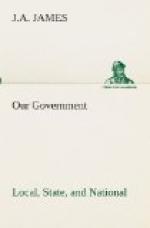Each section is subdivided into rectangular tracts known as halves, quarters, half-quarters, and quarter-quarters. The designations of these divisions are by abbreviations and fractions. (See Figure 3.) The number of acres in each tract is easily computed.
The rectangular system of survey has been a great aid in the subdivision and location of farm lands; it greatly reduces the number of boundary disputes, it determines very largely the location of country roads. Moreover, the Congressional township has become, in a great many instances, the area within which the political township or town has been organized. This town, however, need not coincide with the Congressional township; it may be greater or smaller in area.
[Illustration: Figure 2.—Six MILES SQUARE.
|----------------------------| | 6 | 5 | 4 | 3 | 2 | 1 | |----------------------------| | 7 | 8 | 9 | 10 | 11 | 12 | |----------------------------| |18 | 17 | 16 | 15 | 14 | 13 | |----------------------------| |19 | 20 | 21 | 22 | 23 | 24 | |----------------------------| |30 | 29 | 28 | 27 | 26 | 25 | |----------------------------| |31 | 32 | 33 | 34 | 35 | 36 | |----------------------------|
]
[Illustration: Figure 3.—One mile square
|------------------------------| | | N 1/2 NE 1/4 | | NW 1/4 |----------------| | | | SE 1/4 | | | | NE 1/4 | |------------------------------| | | | S 1/2 | | | |------------------------------|
]
SUPPLEMENTARY QUESTIONS AND REFERENCES.
1. For the history of land cessions, references are given in Government in State and Nation, p. 334, question 1.
2. The topics treated in this chapter are discussed in Harrison, This Country of Ours, pp. 270-279.
3. On public lands, see Reinsch, Young Citizen’s Reader, 90-101. Marriott, Uncle Sam’s Business, 175-184; 254-269.
CHAPTER XVIII.
AMENDMENTS TO THE CONSTITUTION.
Methods of Amending the Constitution.—We have already considered the effect of amendments on some of the original clauses[61]. It now remains to consider, briefly, the methods of amending the Constitution and a few other provisions found in the amendments. Article V provides for amendments as follows:—
The Congress, whenever two-thirds of both houses shall deem it necessary, shall propose amendments to this Constitution, or, on the application of the legislatures of two-thirds of the several States, shall call a convention for proposing amendments, which, in either case, shall be valid to all intents and purposes, as part of this Constitution, when ratified by the legislatures of three-fourths of the several States, or by conventions in three-fourths thereof, as the one or the other mode of ratification may be proposed by the Congress; provided that no amendment which may be made prior to the year one thousand eight hundred and eight shall in any manner affect the first and fourth clauses in the ninth section of the first article; and that no State, without its consent, shall be deprived of its equal suffrage in the Senate.




